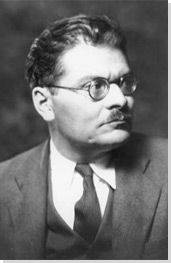Summary of José Clemente Orozco
Of "Los tres grandes" (The Three Greats) of the Mexican Muralists, José Clemente Orozco, notoriously introverted and pessimistic, is in many ways the least revered. One possible explanation for that is that, unlike his colleagues, David Siqueiros and Diego Rivera, Orozco openly criticized both the Mexican Revolution and the post-Revolution government. What was perceived as standoffishness was, by all accounts, the profound despair of a person who felt deeply for others. Orozco's style is a mixture of conventional, Renaissance-period compositions and modeling, emotionally expressive, modernist abstraction, typically dark, ominous palettes, and forms and iconography deriving from the country's indigenous, pre-colonial, pre-European art. Orozco's skill as a cartoonist and print maker is detectable not only in his style but also in his ability to communicate a complex message -- generally, timely political subjects -- simply and on a massive scale. The Mexican Muralist movement as a whole asserted the importance of large-scale public art and Orozco's murals, in particular, made space for bold, open social and political critique.
Accomplishments
- Along with Rivera and Siqueiros, Orozco revived the tradition of Italian Renaissance fresco painting via the large-scale murals meant to engage a wider viewership. The goal was to create a more democratic art form; that is, to make their art - its post-Mexican Revolution, nationalistic themes - accessible to people from all social strata.
- Orozco worked as an editorial cartoonist for two radical political magazines His subsequent murals functioned as massive, and at least semi-public, critiques much in the way a political cartoon in a newspaper or pamphlet potentially engages with a wide audience through broad distribution.
- Like Rivera, Orozco received commissions to produce murals in the United States. His avant-garde, expressionist style combined with the Mexican Muralists' revival of Social Realism, influenced American artists as diverse as Jackson Pollock and Philip Guston, Ben Shahn and Jacob Lawrence.
Important Art by José Clemente Orozco
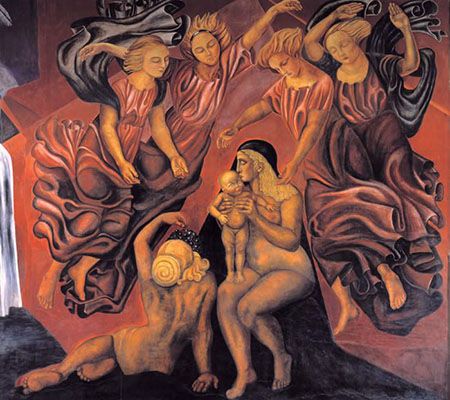
Maternity
This mural is one of Orozco's earliest frescoes, painted for the ground floor of the National Preparatory School (ENP) in Mexico City. Maternity depicts a mother and child; it resembles Renaissance depictions of Mary and the infant Jesus, with the exception of the conspicuous nudity of the mother. Allegorical Boticelli-esque females in deep folds of windblown drapery surround the mother and child. A sensual, reclining nude female turns her back to the viewer as she eats grapes, the fruit associated with Dionysus and celebration. The women are noticeably European: blond and with classical features. The Renaissance influence is striking not only in the representation of the figures themselves but also in the pyramidal composition and the lapis lazuli-colored garment the mother wears, a color traditionally linked to the figure of the Virgin Mary.
Following the Mexican Revolution, the new government encouraged the production of public art to promote a nationalist program of unity, of the concept of an integrated populace or "Mexicanos." However, Orozco's use of overtly European figures seems to challenge the assertion by an increasingly authoritarian government that equality had been achieved. In this work, the beauty standard is European rather than indigenous. Here we see Orozco subtly critique the very institution that commissioned him for the work.
This particular mural is of immense value because it is the only surviving one of Orozco's earliest frescoes, as most were destroyed by conservative students at the ENP while others were demolished by Orozco himself. In fact, a group of Catholic women misinterpreted the secular meaning of Maternity, thought it sacrilegious, and attacked it.
Fresco - National Preparatory School (ENP), Mexico City, Mexico
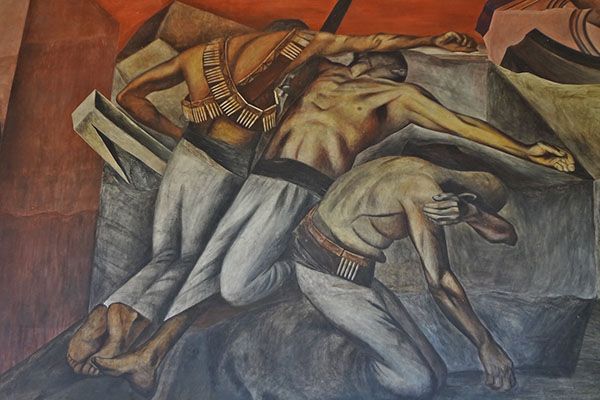
The Trench
Orozco was forced to stop working at the ENP in 1924. He destroyed some of his early work there but returned in 1926 to add a new set of frescoes to the ground floor. The Trench is one of the works that he produced during his second stay at the ENP and is dramatically different from his earlier works at that site such as Maternity. The softly delineated flesh of the figures in the earlier work and the Renaissance elegance of the overall rendering in Maternity has given way to a frank, modernist style in which forms are less modeled, line is expressive, and the palette reflective of the dark, emotional content of the mural.
The Trench depicts soldiers fighting in the Mexican Revolution. The three fallen, faceless men form a cross. The sharp diagonal of the composition and the vivid red of the background convey the scene's drama. Due to Orozco's new interest in modern art, with its representations of space and time as mutable and relative, the three men could be interpreted as a single soldier depicted in different moments in time.
By 1929, the morale of the populace regarding the Revolution had deteriorated considerably compared to the early optimism of 1923. With The Trench, Orozco illustrates his refusal to idealize the Revolution as Rivera and Siqueiros did. Having witnessed it directly (unlike Rivera, who was in Paris) and been thoroughly scarred by the ferocity of his countrymen during the Revolution, Orozco seeks to promote peace by denouncing the violence of revolution. This mural is expressionistic, contrasting with the placid depiction of Maternity.
Fresco - National Preparatory School (ENP), Mexico City, Mexico
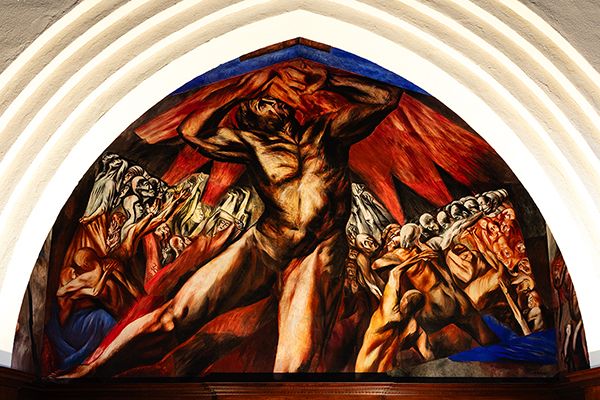
Prometheus
Orozco painted a monumental Prometheus reaching up to the sky to take fire, a symbol of wisdom and enlightenment, from the ceiling panel that depicts stylized flames, representing God, the source of wisdom. The Titan is about to give mankind the power of knowledge for which Zeus will cruelly punish him, as the Greek myth recounts. Around Prometheus stand masses of mortal humans, some eagerly anticipating the gift, others preoccupied or in various states of agitation.
With this mural Orozco opposed the prevailing idea that wall paintings ought to be decorous, impersonal, and pleasant. While the theme is certainly appropriate for a University, Orozco's Expressionism is displayed on a massive scale as no one before him had done. His work, Prometheus, is the first modern fresco in the United States.
Orozco no longer relies on the stable, pyramidal composition of earlier works but rather creates a figure that, while adamantly central, seems to be rising up out of the top of the composition, aided by the frenetic activity on each side, diagonal elements that seem to push the central figure from either side. Flashes of the blue complete with the powerful red flesh, and heavy black marks that create the forceful upward thrust.
Fresco - Pomona College, CA, United States
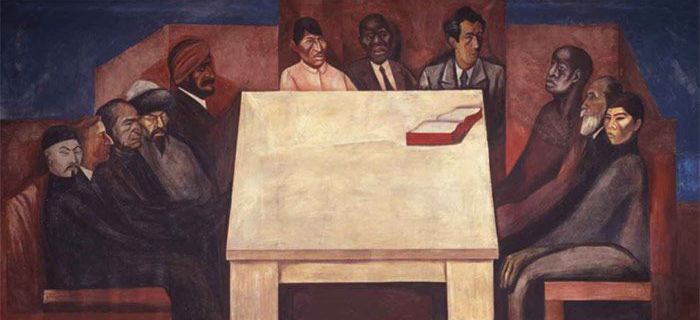
The Table of Universal Brotherhood
This stark scene is one of a series of murals in the "Orozco Room" at The New School in New York City and is complemented by three others, which are allegories of the Mexican Revolution using images of Gandhi, Carrillo Puerto, and Lenin. On a fourth wall is a mural featuring a group of workers and another of slaves who are returning home after a day of heavy labor. The cycle culminates with this view of a victory and an idealized brotherhood of man.
The scene pictured here depicts people of varying nationalities and professions sitting around a disproportionately large table rendered using a tipped-forward perspective; an open book rests on the far right corner. One of the characters, in the role of the festaijuolo in early Renaissance paintings, looks out to the viewer, inviting him -- note that there are no women represented here -- to complete the semicircle at the end of the table that was left explicitly empty.
The style is one of expressionistic economy, devoid of details and excessive rendering. Orozco is said to have constructed the image based on esoteric texts by Jay Hambridge, a geometrician who promoted "geometric-aesthetic principles" in art. The dark, somber palette of the work emphasizes the artist's cynical perspective with respect to the outcome of the Mexican Revolution and the possibility of a pluralistic, democratic governing brotherhood. While he had hoped that the work would galvanize the viewer, not only intellectually but also viscerally, into helping realize just such a universal brotherhood, very little about the image invites optimism or is suggestive of inclusiveness.
In the artistic context of the US in the early 1930s, when artists with styles as disparate as those of Mondrian and Grant Wood were actively producing avant-garde art, a work like this fresco would have been a complete novelty both in terms of scale and function. The murals of the three great Mexican muralists were intended to be accessible to the public, although, in truth, accessibility was often quite limited. Their patrons were frequently institutions that could afford to fund such extensive works and thus the capacity of the murals on the whole to promote the message of Mexican unity was radically diminished and, arguably, limited to an elite viewership.
Fresco - The New School, NY, United States
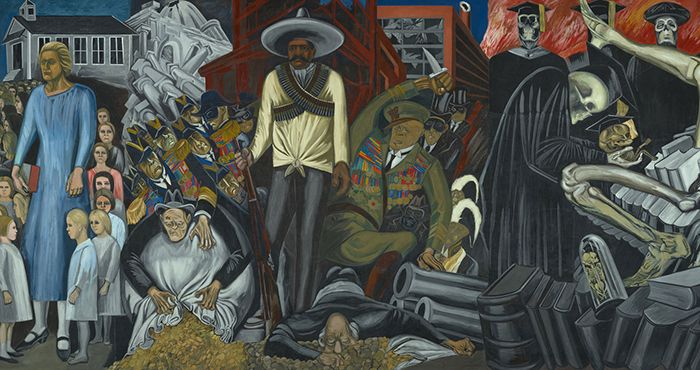
The Epic of American Civilization
This fascinating mural cycle comprised of 24 panels, covering four walls in the Baker Library, is a complex and layered depiction of the history of the American continent. Broken down, it essentially depicts three stages of the Americas: pre-Hispanic times, colonial times marked by the arrival of Europeans, and the modern industrial era. Reducing the story to its bare skeleton, it recounts that, in the beginning, pre-European culture was barbaric and primitive, engaging in human sacrifice and war until the arrival of Quetzalcoatl. Quetzalcoatl is personified here as a pre-Hispanic deity of wisdom who brought learning, science, and art to the people, creating a civilization and ushering in a Golden Age. Eventually, infuriated by those who did not follow his precepts, according to the myth, Quetzalcoatl left promising to return centuries later to destroy the civilization that failed to grasp his message.
The second panel illustrates the return of Quetzalcoatl, incarnated in the figure of Cortes, coming to destroy all native culture and to impose European values on the native civilization. The subsequent panels depict the impact of European technology and culture as well as the consequences of industrialization. Machines that are fed with the corpses of those killed by Cortés represent society's suffocating dependence on modern technology. Similarly, Orozco represents institutional education as sterile and dead, oppressive rather than instrumental to higher learning.
The overarching message of the mural cycle is communicated not only by the narrative, but also by Orozco's style: the first panels are clear and harmonious while the ones depicting modern times are chaotic and overcrowded, causing the viewer to feel overwhelmed. In this particular image, it is possible to detect the strong influence of indigenous art, with the palette of earthtones combined with splashes of bright color, the stylized linearity of the forms, and the pronounced pyramidal arrangement of forms so evocative of the sacred structures of ancient Mexico.
The cycle is crucial in illustrating out a fundamental difference between Orozco and his contemporary Mexican muralists. For instance, Rivera represented the same general theme but infused it with optimism; his cycle characterizes white European colonialism as progress rather than deterioration. Orozco, on the other hand, made the later panels of this cycle grotesquely mirror the beginning ones: Ancient Human Sacrifice becomes Modern Human Sacrifice in such a way that there's no progress at all, but merely the exchanging of one barbaric behavior for another much like it. Thus Orozco brought introspection, criticism, and ambiguity to Mexican muralism as none of his contemporaries had done.
Fresco - Dartmouth College, NH, United States
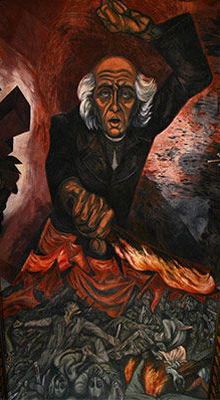
Father Hidalgo
When ascending the main staircase of the Government Palace, the viewer will be dwarfed by the enormous (over 13,000 square feet) fresco covering the ceiling and walls. In this work, Orozco's skill as a cartoonist stands out prominently. Just as likely, the influence of both indigenous art and modernist abstraction play key roles in the artist's move away from Renaissance-influenced rendering. Figures and objects, most all of which are painted in stark, sobering shades of gray to contrast with the flame-like orange and red that surrounds Hidalgo like a mandorla, are described using the most economical and stylized of means. The sweeping, curvilinear outlines of forms both distinguish one from the next and create a seemingly unified, swirling, chaotic mass of desperate humanity.
This mural depicts Miguel Hidalgo, a priest who called the Indian people to revolt on September 16, 1810. Although the revolt was unsuccessful, he is regarded as the person who instigated the Mexican push for independence. In the mural, Hidalgo, stern-faced and monumental, in scale as only a pantocrator would be depicted, offers a sick and war-ridden mankind fire - a clear allusion to the Prometheus myth.
In keeping with his alternative, anti-colonial readings of Mexican history, Orozco sought both to praise Hidalgo for his role in encouraging the Indians' rebellion and to condemn him, a Roman Catholic priest, whose task it was to indoctrinate the Indians in a foreign faith. Thus, as Orozco framed it, while Hidalgo fought for the oppressed he was also tragically contributing to their oppression. In line with his anarchic ideals, Orozco condemns all institutional creeds in this complicated series of images.
Fresco - Government Palace, Guadalajara, Mexico
Biography of José Clemente Orozco
Childhood and Education
Orozco, one of four brothers, spent his first years in the southwestern region of Jalisco, Mexico. His father had a soap, ink, and coloring factory in addition to being an editor for the newspaper, La Abeja. His mother was a housewife who occasionally gave the women of the community painting classes. The family moved first to Guadalajara and then Mexico City in the hopes of improving their financial situation. Despite their efforts, however, the times were not easy for middle-class families and it was often difficult for the family to make ends meet.
On his way to and from school the young Orozco would pass by the shop where José Guadalupe Posada - a politically engaged cartoonist famous for his images of skulls and skeletons - worked in full-view from the street. Fascinated, Orozco started to experiment with drawing and coloring, later recalling the experience of watching Posada work as an "awakening" to the existence of art. He began to take evening drawing classes.
Later, he was urged (forced, rather) to study agricultural engineering for the sake of financial security. It was only after his father's death that Orozco became fully committed to pursuing an artistic career. A remarkable decision considering he had lost his left hand after manipulating fireworks for Independence Day celebrations in 1904. Since most doctors were on holiday, by the time treatment was available for the injury, gangrene had taken over and it had become necessary to amputate his entire hand.
Orozco studied full-time at the San Carlos Academy from 1906-14, and participated at the 1911 student's strike along with fellow student and future muralist David Alfaro Siqueiros. It was in night classes at the Academy where Orozco met Dr. Atl (Gerardo Murillo), the slightly older artist who frequently shared captivating stories of his adventures in Europe. Dr. Atl was a fervent advocate of promoting a distinctively Mexican art and was opposed to copying the European style that was a requisite activity in the Academy. It was with the confidence that Dr. Atl instilled in his young students that Orozco began experimenting with Mexican landscapes and introducing familiarly vibrant colors into his paintings. It was the seed that developed into the artistic emancipation of Mexico.
Early Period
In the early years of his artistic career, Orozco worked as a caricaturist for various oppositional newspapers. He landed a solo exhibition of his watercolors depicting female prostitutes and men past their prime, poignantly entitled "The House of Tears." Perhaps as a mirror to his own struggles, Orozco's focus on human suffering was a predominant theme in his early work. Despite this recognition of his artistic merit, Orozco found himself painting dolls to pay the bills.
During the violent battles of the Mexican Revolution, Orozco worked as an illustrator for a pro-Carranza newspaper called La Vanguardia. He witnessed the carnage of the Revolution first-hand, an experience that would forever mark his work and heavily contribute to a pessimistic outlook on life. He said of the Revolution: "The world was torn apart around us. Troop convoys passed on their way to slaughter ... Trains back from the battlefield unloaded their cargoes in the station in Orizaba: the wounded; the tired; exhausted, mutilated soldiers, sweating and tatterdemalion. In the world of politics it was the same, war without quarter, struggle for power and wealth. Factions and sub-factions were past counting, the thirst for vengeance insatiable" Unlike Rivera and Siqueiros, the other two famous muralists who, along with Orozco, made up the avant-garde muralists known as "Los tres grandes" (The Three Greats), Orozco was an anarchist. He was vehemently anti-institution, anti-military, anti-clerical, anti-establishment, and so forth, because he felt these institutions were all inevitably and inherently corrupt.
Orozco took up residence in the United States from 1917 to 1919, working mainly as a sign-painter first in San Francisco, and then in New York. He met with Siqueiros one night as the latter was on his way to Europe and went to dinner along with Xavier Guerrero, where they argued profusely about the future of art in Mexico. In 1920, he returned to Mexico, where he received his first public commission at the National Preparatory School as part of the new government's plan to broadcast its messages of a modern Mexican identity.
He married Margarita Valladares in 1923 and the couple had three children. In the following years, Orozco's colleagues in the arts admired him greatly. Despite the praise from this small intellectual elite, however, Orozco was generally underappreciated in his country. He left his family in 1927 to work in the United States, where he witnessed the effects of the Great Depression first-hand. He befriended the journalist and arts patron Alma Reed, who had fallen in love with a Mexican governor on a work trip to Mexico only to discover he had been murdered during the Revolution while she returned to the US for the wedding preparations. Alma Reed invited Orozco to her intellectual soirees and showed his work in her house. On one of these evenings, the Greek Orthodox patriarch in New York saw in Orozco's work the greatness of classical antiquity and crowned him with a symbolic laurel wreath. During his stay in the US, he painted some of his most famous murals in Pomona, the New School, Dartmouth, and the Museum of Modern Art.
Mature Period
In 1932 Orozco traveled to Europe for the first time, visiting all the compulsory museum destinations. He returned to Mexico as a greatly respected artist and painted his masterpiece at the Hospicio Cabañas in Guadalajara, hailed as the "Sistine Chapel of the Americas," and eventually named a UNESCO World Heritage site.
A testament to his technical virtuosity, Orozco would apply paint directly onto the wall in the notoriously unforgiving fresco technique without sketching the mural beforehand. His preparatory sketches were made solely on paper, never on the mural itself. He was known to be a taciturn man, generally preferring his own company and quiet work in his studio, an almost binary opposite to the garrulous personality of his friend and sometimes rival, Diego Rivera.
Around 1943, Orozco met the prima ballerina of the Mexico City Ballet, Gloria Campobello, for whom he left his first wife. The couple lived together in New York until 1946, when Campobello ended the relationship abruptly. He then returned to Mexico to live alone.
Later Period
Orozco's oeuvre from the 1940s included many portraits and a series of anti-clerical and anti-military paintings. In 1946, he was awarded the national Prize for his murals in the Church of the Hospital of Jesus. In 1947, he illustrated Nobel prize-winning author John Steinbeck's book, The Pearl, at Steinbeck's request. That same year he had a major retrospective exhibition in Mexico's most important museum, the Palacio de Bellas Artes.
Orozco's numerous self-portraits enable us to understand his personality. He depicts himself as an intellectual and a dour man of intense reflection. His eyes have the piercing hardness of a witness inured to some of the most horrid aspects of our species. One can picture him enraged or melancholy but is hard pressed to find any joy in his countenance. Indeed, Octavio Paz remarked "Orozco never smiled in his life". He completed his last fresco in 1949. He died of heart failure in his sleep, aged 65.
The Legacy of José Clemente Orozco
Orozco's views on the Mexican Revolution differed radically from those of Diego Rivera and David Alfaro Siqueiros. Unlike the idealistic Rivera or the belligerent Siqueiros, Orozco had a deeply cynical regard for the revolution; he was disturbed by the extensive bloodshed and death toll, and skeptical of the potential of the protracted upheaval to benefit those who it seemed clear would suffer regardless of which forces prevailed. Orozco's focus from his earliest works onward centered on human suffering, no doubt a byproduct of the hardships he had suffered and witnessed in his own life. He had a notorious inability to connect with others on a one-to-one basis but showed tremendous empathy for humanity as a whole. Perhaps ironically, his greatest legacy is to have challenged the very nationalist sentiment that provided him with longstanding renown.
The artists inspired by Orozco range from the Mexican painter, sculptor and poet, Gustavo Arias Murueta, to Joan Mitchell, Rico Lubrun, Eleanor Coen, and Luis Nishizawa. Furthermore, an early phase of Jackson Pollock, when he was undergoing therapy with a Jungian doctor, is influenced by Orozco's work. In fact, Pollock and Philip Guston travelled together on an artistic pilgrimage to see Orozco's Epic of American Civilization. Pollock also declared Prometheus the greatest contemporary painting in North America.
Influences and Connections

![Gerardo Murillo]() Gerardo Murillo
Gerardo Murillo
-
![Jackson Pollock]() Jackson Pollock
Jackson Pollock -
![Philip Guston]() Philip Guston
Philip Guston ![Reuben Kadish]() Reuben Kadish
Reuben Kadish![Charles White]() Charles White
Charles White
Useful Resources on José Clemente Orozco
- José Clemente Orozco in the United States, 1927-1934Our PickBy Renato Gonzalez Mello
- José Clemente Orozco: Mexican Artist (Hispanic Biography)By Barbara Cruz
- Mexican Muralists: Orozco, Rivera, SiqueirosOur PickBy Desmond Rochfort
- José Clemente Orozco- La Pintura Mural MexicanaBy Renato Gonzalez Mello
- Men of Fire: José Clamente Orozco and Jackson PollockBy Hood Museum of Art, Mary K. Coffey, Sharon Lorenzo, Lisa Mintz Messinger, and Stephan Plcari
- The Pearl (Illustrated by José Clamene Orozco)Our PickBy John Steinbeck
- José Clemente Orozco: PrometheusBy Majorie L. Harth and Jose Clemente Orozco
- Orozco: Hospicio Cabanas (Jalisco En El Arte)By Echavarria, Salvador, and Alvarez
 Ask The Art Story AI
Ask The Art Story AI